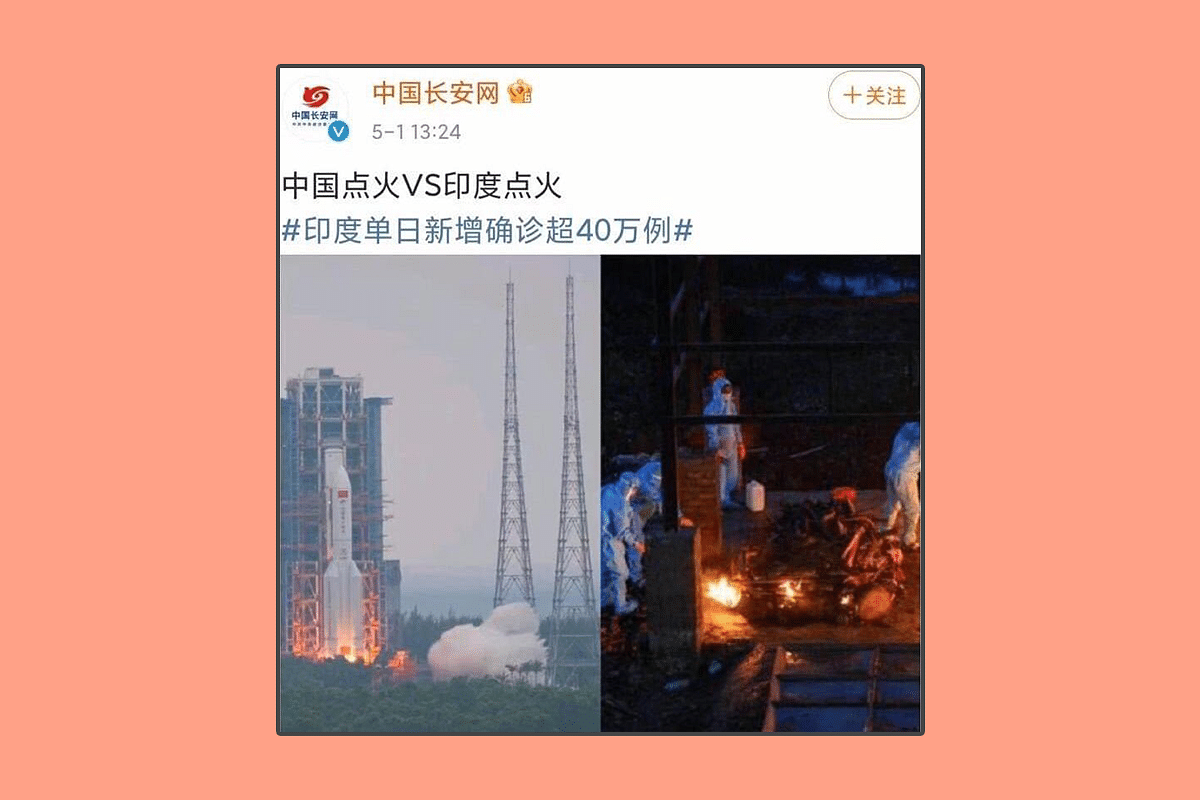News Brief
Nothing Is Forgotten: China Faces Backlash For Mocking India’s Covid Crisis On Social Media
- A post on Chinese social media site Weibo showed an image of a rocket launch in China, along with another image of the cremation ceremonies of India’s Covid-19 victims.
- The social media handle which posted the collage belonged to an official Chinese law enforcement agency.

The social media post in question
The entire world knows that India has been facing an unprecedented surge in Covid-19 cases and the country is trying to control the current situation.
At a time when nations like the United States, United Kingdom and Russia are sending medical supplies to support India during this crisis, an especially insensitive image appeared on a popular Chinese social media site.
A social media post, reportedly published by an account belonging to an official Chinese law enforcement agency—the Communist Party's Central Political and Legal Affairs Commission—has sparked controversy for appearing to mock India’s current Covid-19 crisis.
The post on Chinese social media site Weibo showed an image of a rocket launch in China, along with another image of the cremation ceremonies of India’s Covid-19 victims.
The post, which has since been deleted, included a text which read: "Lighting a fire in China VS lighting a fire in India."
The account which posted the collage of images on 1 May has millions of followers on Weibo, which is a popular microblogging site in the country.
But many users responded to the post saying it was "inappropriate" and China should “express sympathy to India”.
As reported by the BBC, the editor-in-chief of China's Global Times media outlet, Hu Xijin wrote: "Hold high the banner of humanitarianism at this time, show sympathy for India, and firmly place Chinese society on a moral high ground."
The image appeared a day after Chinese President Xi Jinping sent a message of condolence to Prime Minister Narendra Modi regarding the massive health crisis.
China also expressed that it wants to enhance cooperation with India and provide additional help.
But the post once again reminded India that there will always be people inside the Chinese regime who will never show compassion or feel sorry for the role of the Chinese Communist Party (CCP) in the initial stages of the coronavirus crisis.
How China Handled Covid
Towards the end of 2019, when Dr Li Wenliang—now known as Chinese coronavirus whistleblower—tried to alert people about the pandemic, he was silenced by the Chinese authorities.
The ophthalmologist in Hubei's Wuhan city was asked to keep quiet, as the local authorities claimed that he was just spreading rumours.
Dr Li died in February after contracting coronavirus.
Many citizen journalists went missing after they tried to report about the Covid-19 situation in China’s Wuhan, where coronavirus first emerged and then spread across the globe.
One of them was Zhang Zhan who faced backlash from the Chinese regime for covering the coronavirus outbreak in Wuhan.
In January, she was sentenced to four years in prison in China.
Last year, one former CCP member Cai Xia claimed that China never released the actual death toll.
China has been at the focus of every discussion and criticism related to the Covid-19 crisis since day one.
The country knew that the virus was spreading and the situation was out of control in early January 2020.
But it did not inform the World Health Organization (WHO).
Even during the WHO’s investigation to find out the source of Covid-19, initially, CCP did not cooperate.
After developing vaccines at home, the CCP-ruled China also questioned the efficacy of the jabs developed by other countries.
According to a report by AP, Fang Shimin, who is a popular Chinese science writer, now based in the US, said that China was trying to promote its own vaccines while letting people remain in doubt about other jabs.
Support Swarajya's 50 Ground Reports Project & Sponsor A Story
Every general election Swarajya does a 50 ground reports project.
Aimed only at serious readers and those who appreciate the nuances of political undercurrents, the project provides a sense of India's electoral landscape. As you know, these reports are produced after considerable investment of travel, time and effort on the ground.
This time too we've kicked off the project in style and have covered over 30 constituencies already. If you're someone who appreciates such work and have enjoyed our coverage please consider sponsoring a ground report for just Rs 2999 to Rs 19,999 - it goes a long way in helping us produce more quality reportage.
You can also back this project by becoming a subscriber for as little as Rs 999 - so do click on this links and choose a plan that suits you and back us.
Click below to contribute.
Latest